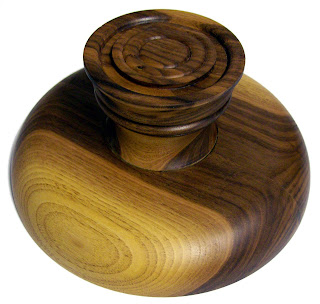 These hand-turned solid hardwood goblets are made from ambrosia maple. Ambrosia refers to the fungus that causes the black streaks. It's introduced by beetles that cary the spores with them. They burrow in to dead maple trees, lay eggs, and leave, and the spores they leave behind begin to break down the walls of the hole into food the larvae can eat. When they grow up and leave, they take the spores with them. The fungus only exists in symbiosis with the beetles, and the beetles can't live without the fungus. Cool stuff. The resulting staining pattern in the maple is distinct, dramatic, and beautiful.
These hand-turned solid hardwood goblets are made from ambrosia maple. Ambrosia refers to the fungus that causes the black streaks. It's introduced by beetles that cary the spores with them. They burrow in to dead maple trees, lay eggs, and leave, and the spores they leave behind begin to break down the walls of the hole into food the larvae can eat. When they grow up and leave, they take the spores with them. The fungus only exists in symbiosis with the beetles, and the beetles can't live without the fungus. Cool stuff. The resulting staining pattern in the maple is distinct, dramatic, and beautiful.Turning these goblets was exciting and challenging - the hollowing technique for endgrain is completely different from that used for sidegrain like in bowls. It was also a challenge to make the two goblets look the same. There are subtle differences that are a mark of hand-turned work. These were made as a set for a gift for a bridal shower.
 This second set was made much later for a different customer - same kind of wood, but different shape.
This second set was made much later for a different customer - same kind of wood, but different shape.Goblets this size (3" diameter x 8" height, approximate) start at $55 each from ambrosia maple. Other woods are available but may be priced differently. Order more than one and get $10 off your order.By clicking on "Order Now," buyer agrees to these terms.





 This hand-turned wood salad bowl is a segmented bowl made from bloodwood, maple, purpleheart, and walnut. The contrasting woods make a dramatic and beautiful bowl. It's 9.5" in daimeter and 5" high, and finished with mineral oil and beeswax for a food-safe finish. It can be hand-washed and restored with oil and be used over and over for years. It can be ordered individually or as part of a set. If you'd rather have other colors, you can choose from basically any of the woods at Macbeath Hardwood's
This hand-turned wood salad bowl is a segmented bowl made from bloodwood, maple, purpleheart, and walnut. The contrasting woods make a dramatic and beautiful bowl. It's 9.5" in daimeter and 5" high, and finished with mineral oil and beeswax for a food-safe finish. It can be hand-washed and restored with oil and be used over and over for years. It can be ordered individually or as part of a set. If you'd rather have other colors, you can choose from basically any of the woods at Macbeath Hardwood's  The profile shows the flared design that my wife wanted (this one's hers, but I'd love to make more), while the top view shows the spiraling colors.
The profile shows the flared design that my wife wanted (this one's hers, but I'd love to make more), while the top view shows the spiraling colors.














 Price for a similar bowl: $12 plus wood. (6"x2")
Price for a similar bowl: $12 plus wood. (6"x2")